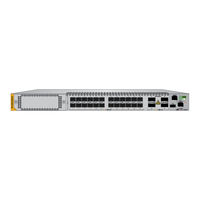Allied Telesis AT-x950-28XTQm Manuals
Manuals and User Guides for Allied Telesis AT-x950-28XTQm. We have 2 Allied Telesis AT-x950-28XTQm manuals available for free PDF download: Installation Manual
Allied Telesis AT-x950-28XTQm Installation Manual (292 pages)
Brand: Allied Telesis
|
Category: Switch
|
Size: 14 MB
Table of Contents
-
Preface15
-
Features22
-
Leds26
-
Leds28
-
Leds31
-
USB Port36
-
Leds49
-
Overview62
-
Copper Ports65
-
Copper Ports69
-
Leds70
-
Copper Ports71
-
Leds72
-
Leds74
-
Leds77
-
Leds79
-
Overview82
-
Stack Trunks84
-
Planning a Stack103
-
Required Items150
-
Introduction174
-
Inner Rails175
-
Command Summary198
-
Stackport199
-
Stack Enable200
-
Stack Priority200
-
Stack Renumber201
-
Switch Provision201
-
What to Do Next218
-
What to Do Next229
-
Certifications289
Advertisement
Allied Telesis AT-x950-28XTQm Installation Manual (166 pages)
Advanced Layer 3+ Stand-alone Switches
Brand: Allied Telesis
|
Category: Switch
|
Size: 4 MB
Table of Contents
-
Preface11
-
-
Features18
-
Leds21
-
Leds23
-
Leds25
-
RJ-45 Ports30
-
Leds31
-
Transceivers34
-
Leds35
-
Transceivers36
-
Leds36
-
Transceivers38
-
Leds38
-
USB Port40
-
Leds47
-
-
-
-
-
-
-
-
-
Certifications164
Advertisement
Related Products
- Allied Telesis AT-x950-28XSQ
- Allied Telesis AT-x950-52XTQm
- Allied Telesis AT-x950-52XSQ
- Allied Telesis AT-x900-12XT/S
- Allied Telesis AT-x900-48FS
- Allied Telesis AT-x900-48FE-N
- Allied Telesis Switchblade AT-x908
- Allied Telesis AT-x930-52GTXAT-x930-52GPX
- Allied Telesis Switchblade AT-x900-24
- Allied Telesis Switchblade AT-x900-12

